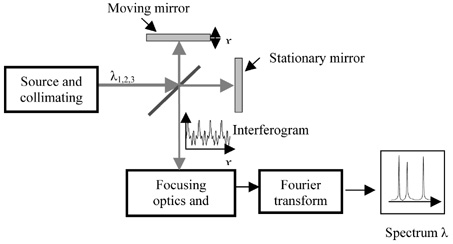Optipedia • SPIE Press books opened for your reference.
Fourier-Transform Spectrometers
Excerpt from Fourier-Transform Spectroscopy Instrumentation Engineering
A Fourier-transform (FT) spectrometer generates the spectrum of its source radiation by modulating the radiation in the time domain through interference, which is then Fourier transformed. Here, a general overview of its operation is presented. The figure below shows the main components of an FT spectrometer and illustrates the overall process in obtaining the spectrum.
Briefly, the interference between the lights reflected off the moving and the stationary mirrors generates what is called an interferogram, I(x), a modulated radiation signal as a function of the displacement of the moving mirror. This is the analog signal recorded at the photodetector, which encodes the wavelength or the wave number* information from the source radiation. A Fourier-transform routine is then performed on the interferogram to obtain the spectrum.

A Fourier-transform spectrometer using a Michelson interferometer. The interferogram contains the source’s frequency information modulated in a time domain as a function of the moving mirror’s displacement. The interferogram is Fourier-transformed to obtain the spectrum.
*Wave number = 1 / wavelength, given in cm–1.
V. Saptari, Fourier-Transform Spectroscopy Instrumentation Engineering, SPIE Press, Bellingham, WA (2003).
View SPIE terms of use.
Non-Member: $52.00

